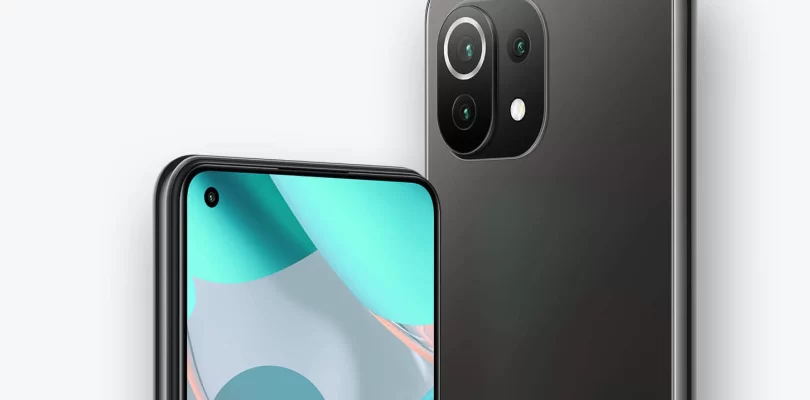Design: thinness and lightness by flag
No half measures: this is the lightest and thinnest 5G mobile on the market. That is what Xiaomi says, although, in reality, it should be said that it is the thinnest, but not the one that weighs the least. keep reading review.
The reason is simple. While the 158 grams of this model make it a featherweight in the Android ecosystem, the iPhone 13 Mini weighs 141 grams, much less. Of course, the normal iPhone 13 already goes to 174 grams.
Marketing technicalities aside, the Xiaomi 11 Lite 5G NE is a pleasure to use and carry in your hand in terms of materials and design.
It is a comfortable device, not small in dimensions except in thickness and very light. This is appreciated on a day-to-day basis and draws the attention of anyone who takes it.
Special mention to the finish the white color with a very characteristic shine.
Despite this, which is the good thing, having the name it has brings it partly closer to the high-end, and there we pay the price of not having a headphone jack. Curiously, we do have a micro SD slot, although we must remove one of the two SIMs that this device supports.
Performance is not what we expected
If the design is the best thing about this device, the performance is at the cross of that same coin.
On paper, the 6 and 8 GB of RAM of the two available versions and the chosen processor, the Snapdragon 778G, should give enough performance to perform all kinds of tasks, but it is not like that.
If we want to use normal applications such as Instagram, Gmail, Google Maps, and others, we will see how the device fulfills more than enough.
The problem is wanting to enjoy advanced games, where we already see that the graphic performance drops and that the speed of the animations and others can be greatly improved. There was a time that a terminal of this category did not disappoint me so much.
It is especially noticeable in demanding games, of course, but sometimes I have also seen that the interface has hung without showing the desktop.
It may be an optimization problem, not a hardware problem, but the experience has not been as satisfactory as we would have liked. And yes, it is possible that if I did not play so much with the mobile, I would not have cared, but this is not a model of 100 euros precisely.
An excellent screen, although we miss the 120 Hz
The screen is the same as that we have in the Xiaomi 11 Lite, so we will not complain. At least no more than in that analysis.
In terms of use, Xiaomi has been right by opting for an OLED panel, with a high refresh rate of 90 Hz, support for HDR, and even an acceptable maximum brightness.
The negative part is that it is shocking to see a terminal like the Redmi Note 10 Pro with 120 Hz when it does not have it, although it is true that in this case, we have the fingerprint sensor on the screen. It may have been cut here for autonomy, although Xiaomi has not expressly said so.
In addition, reflections are high in some scenarios, although the panel is a positive aspect of this terminal.
A very valid camera system but without a telephoto
The photographic section of this mobile perfectly summarizes the reality of having a terminal of about 350 euros in hand.
It takes very decent photos in good light; it has a portrait mode that works well, a wide-angle that even surprises, despite having only 8 Mpx, and a daytime video recording more than remarkable.
We only put the problems at night, not in the main camera, but in the front, which falters a lot, and in video recording in any of its modalities. You can see it in the video analysis.
Of course, the worst thing is to have three cameras, one being a macro instead of a telephoto, but we are used to it now. Unfortunately.
A good battery, but no crazy stuff
The Xiaomi 11 Lite 5G NE has 4250 mAh of battery, less than the Redmi, but enough to fight for a day in all the tests we have done. And the loading speed is adequate for this category, with 33 W. Of course, seeing what Redmi is going to present, it seems that Xiaomi should also enhance the next Xiaomi 12 Lite or similar.
In the first load test, we have made a somewhat different use. We have been mostly indoors, under Wifi coverage, but we have downloaded the copy WhatsApp security a, several GB, and a lot of data from Honkai Impact Third. We have played and used social apps. Outdoors we have talked and listened to music. We have reached 5 and a half hours of the screen with a total of 24 hours of autonomy, and that with 90 Hz active.
Xiaomi 11 Lite 5G NE
In the second load test, we put the screen at 60 Hz, talked on the phone, listened to music and podcasts for a long time, and took some photos. And played, of course. We have reached 6 hours of the screen with 36 total hours of autonomy.
In the third load test, we have kept the screen at 60 Hz, but we have made much more use of the mobile outdoors, with high brightness, we have listened to music, we have taken photos … We have reached 4 hours of the screen with 36 total hours of autonomy.
MIUI 12.5 behaves well, even if it is dense
Xiaomi has notably improved the fluidity and speed of MIUI in recent months. It is not as heavy as before, although it is far from being a light interface.
The usual details are appreciated, such as having the app search bar at the bottom of the application drawer, which allows you to put and remove the double column of notifications (to use or not the control center) come on, everything we saw in the video that we dedicated to this interface and that is still valid.




